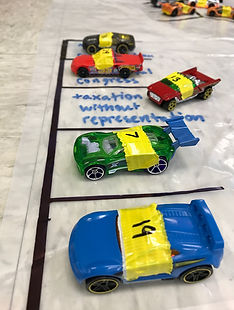Cars

Gist: Leverage the fun of playing with cars to match answers to problems.
Why Do It?
What kid doesn’t love playing with toy cars? Even big kids do! Use the sheer fun of playing to lower the defensive walls and get students interacting with each other and the content.
Materials:
-toy cars (use the cheap ones, hand-me-downs, etc), 30 total
-a stip of plastic drop cloth (use leftovers from making Giant Grid [pg #], Candy Land [pg #], or Giant Bull’s-Eye [pg #])
-colored masking tape or permanent marker
-an assignment and answer key
Directions to Make:
-
Use the masking tape or permanent marker to mark parking spaces along the strip of plastic drop cloth, 30 total.
Set Up:
-
Cut apart the answer key and tape one answer to each car.
-
Number the parking spaces. If some spaces are unused, mark them out.
To Play:
-
Give each student a copy of the worksheet.
-
Give each student a car or let them select one.
-
Students work problems to try to figure out which problem number their answer matches.
-
At your signal, students “drive” their car and park it in the space they believe their problem matches. If two cars try to occupy the same space, students must determine which match is correct.
-
Redistribute cars and repeat.
Variations:
-Demolition Derby! As an optional way to distribute cars at the beginning of each round of play, give every student a car or have them select one. Then they sit in a large circle on the floor, and at your signal, they shove their car toward the middle to cause catastrophic accidents. You can even allow them to continue grabbing and shoving cars. Then, at your signal, they claim the car closest to them as the one they use.
-Demolition Derby can be used to send students to stations. Number each car (see below), and number station activities around the room. For example, numbers 1, 7, 13, and 22 might all go to one station. Then students go to the station their car indicates. You can even interrupt work at a certain point, redistribute cars to mix students back up, and then students continue the work the previous group at their new station started. This can be done quite simply by just putting different worksheets at each station (or essay questions, etc). This will allow students to interact with the content and each other in different ways.
-You can allow students to claim their space as soon as they have their problem figured out. This narrows the remaining answer choices for students who are still working. You’ll need an extension activity ready for those finished students to move on to.
-A variation with lower difficulty is to number the cars by using a strip of Duck tape and then writing one number on each. Then write the answers on the parking spaces using dry erase marker. Students each get a car using any method, and then they work that problem and park it at the corresponding space. It is easier to work problem-to-answer, and students will work only that problem instead of the several they would probably work using the original method above.
-This Worksheet Buster could be used to match vocabulary words and difinitions by putting one on the cars and the other on the spaces.
Caution and Tips:
-If using Demolition Derby, watch out for smashed fingers. Set clear parameters for how cars may be shoved. Amazingly, some cars seem to have the ability to fly! Others seem to have heat-seeking capabilities.
Differentiation Ideas:
-Use color to limit match possibilities. You can write the number on the parking space in different colors and highlight or mark the answer on the cars with the same color. You can select problems appropriately for students that way or tip them off what color they should be looking for.
-If using the variation where students park their cars as soon as they have their problem figured out, it will naturally narrow answer choices for remaining students, providing natural support for students who may need it.




